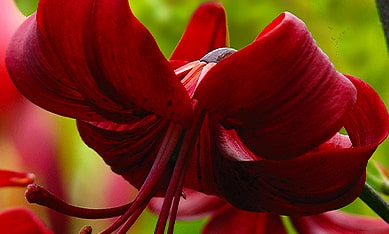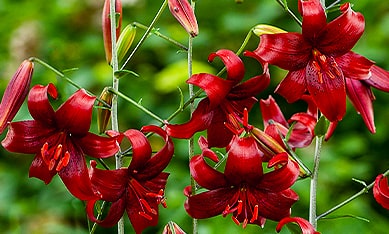Pearl Lilies
Pearl Lilies
Last Reviews
All About Pearl Lilies: Types, Meaning, and Care Tips
Pearl lilies, also known as Calla Lilies or Zantedeschia, are a popular flowering plant known for its striking trumpet-shaped flowers and glossy, spear-shaped leaves. Here is some information about Pearl Lilies types, meaning, and care tips.
Types of Pearl Lilies:
Zantedeschia aethiopica, also called the common calla lily, has enormous, white blossoms and can reach heights of three feet.
Zantedeschia rehmannii: This variant, which comes in pink, red, and orange hues, has smaller blossoms than the typical calla lily.
This species of Zantedeschia elliottiana has yellow flowers and can reach two feet.
This species, Zantedeschia odorata, is distinguished by its fragrant white blossoms.
Meaning of Pearl Lilies:
Pearl lilies are associated with purity, rebirth, and resurrection. They are often used at weddings and funerals to symbolize new beginnings and the cycle of life.
Care Tips for Pearl Lilies:
Light: Pearl lilies require bright, indirect sunlight. Avoid placing them in direct sunlight, as this can burn their leaves.
Water: Keep the soil evenly moist, but not waterlogged. Allow the top inch of soil to dry out before watering again.
Temperature: Pearl lilies prefer 60-75 degrees Fahrenheit.
Fertilizer: Feed your pearl lilies every 2-3 weeks during the growing season with a balanced fertilizer.
Potting: Pearl lilies prefer well-drained soil and should be planted in a pot with drainage holes.
Repotting: Repot your pearl lilies every 1-2 years, or when the plant outgrows its pot.
Pests and Diseases: Pearl lilies are susceptible to spider mites and aphids. Treat any infestation promptly with insecticidal soap or neem oil. Watch out for root rot, which can occur if the plant is overwatered.
The Meaning and Symbolism Behind Pearl Lilies: What Do They Represent?
The Pearl Lily symbolizes purity, innocence, and hope. Its also said to represent femininity and motherhood, making it a popular choice for gifts on Mothers Day or to celebrate the birth of a new baby. In Chinese culture, the Lily is associated with abundance and prosperity. In Christian tradition, its often depicted in paintings of the Annunciation, representing the purity and holiness of the Virgin Mary.
Types of Pearl Lilies: A Guide to Popular Varieties and Their Characteristics
Pearl lilies, commonly known as Calla Lilies, are common decorative plants used in flower arrangements and as garden plants. Pearl lilies come in a variety of varieties, each with its own distinct qualities. Heres a rundown of some of the most prevalent types:
- The most well-known type of pearl lily is Zantedeschia aethiopica, also known as the common calla lily. It has enormous white trumpet-shaped blooms with a yellow spadix in the middle. The leaves are heart-shaped and dark green.
- Zantedeschia elliottiana: Yellow flowers with a green throat are produced by this cultivar. The leaves are arrow-shaped and thin.
- Zantedeschia rehmannii: This cultivar, sometimes known as the pink calla lily, has pink blooms with a yellow spadix. The leaves are lance-shaped and dark green.
- White flowers with yellow centers and green speckles on the petals are produced by Zantedeschia albomaculata. The leaves are arrow-shaped and pale green.
- Zantedeschia odorata has creamy white blooms with yellow spadix. The leaves are tall and shiny.
- Zantedeschia hybrid: Pearl lilies have various hybrid variations that come in a variety of hues, including pink, red, orange, yellow, and even black. These hybrids, which often have broader blossoms than other varieties, can be used as cut flowers or in garden displays.
- Pearl lilies are an elegant and flexible complement to any garden or flower design. Their distinct forms and hues stand out and appeal to any environment.
Asiatic vs. Oriental Lilies: Differences in Appearance, Care, and More
If youre trying to decide between an Asiatic or Oriental Lily, there are a few key differences to remember. Asiatic Lilies are generally smaller and more compact, with upward-facing blooms in a wide range of colors. Theyre also more tolerant of cold temperatures and require less sunlight than Oriental Lilies.
On the other hand, Oriental Lilies are larger and more fragrant, with downward-facing blooms in shades of white, pink, and red. They prefer warmer temperatures and require more sunlight than Asiatic Lilies. Both types of Pearl Lilies are easy to care for, however, and will reward you with stunning blooms year after year.
Planting Pearl Lilies: How to Grow These Beautiful Blooms in Your Garden
When planting Pearl Lilies, its important to choose a location with good soil drainage and plenty of sunshine. The bulbs should be planted in the autumn, 6 inches deep, and 9 to 12 inches apart. After planting, give the earth a good drink and keep it damp but not soggy.
When your Pearl Lilies start to develop, treat them with a slow-release fertilizer to promote robust growth and blooms. Throughout the growth season, be sure to maintain moist soil and cut any dead or damaged leaves as necessary.
When Do Pearl Lilies Bloom? A Seasonal Guide to Flowering Times
Pearl lilies, also known as Calla Lilies, are popular ornamental plants that produce strikingly beautiful flowers. Pearl lilies flower depending on the variety and growing conditions. Heres a seasonal guide to pearl lily blooming times:
- Spring:
Some pearl lilies may bloom in late winter or early spring, depending on climate and soil conditions. This is particularly true for house plants or those grown in warmer regions.
- Summer:
Summer is the most common time for pearl lilies to bloom. Depending on the variety, flowering may start as early as May or June and continue through August or September. The blooming period can last for several weeks or even months, and the flowers can be cut for floral arrangements.
- Fall:
In cooler climates, pearl lilies may bloom into fall. Flowers may become smaller and less vibrant as the temperature drops, but they can still add beauty to a garden or indoor space.
- Winter:
Pearl lilies are not typically winter bloomers, although some varieties may bloom in milder winter climates. In general, plants go dormant in winter, and leaves may die back. Its imperative to protect the dormant plant from frost or freezing temperatures, which can damage or kill the rhizome.
Overall, pearl lilies can bloom during different seasons depending on variety and growing conditions. With proper care and attention, these stunning plants can add color and beauty to your garden or indoor space for many months of the year.
Are Pearl Lilies Deer Resistant? Tips for Protecting Your Garden
One of the benefits of planting Pearl Lilies is that theyre generally deer resistant. This means theyre less likely to be eaten or damaged by deer. However, its still important to protect your garden from other animals and pests.
You can try using physical barriers like fences or netting to keep animals away from your plants. You can also use natural repellents like garlic or peppermint oil. Another option is to plant companion plants like marigolds or lavender, which can help deter pests and attract beneficial insects to your garden.
Pearl Lilies Bulbs: How to Store and Replant for Year-Round Blooms
If you want to enjoy Pearl Lilies year after year, its important to know how to store and replant the bulbs. After the flowers have bloomed and the foliage has died back, you can dig up the bulbs and store them in a cool, dry place. This is until you plant them again in the fall.
When replanting, choose a spot with well-drained soil and plenty of sunlight. Plant the bulbs 6 inches deep and 9-12 inches apart, water thoroughly, and fertilize with a slow-release fertilizer. With proper care and maintenance, your Pearl Lilies will continue to bloom and bring joy to your home or garden for years to come.
Frequently asked questions about Spring Flowering Pearl Lilies
Do you need a lot of care for lilies?
Pearl lilies are comparatively easy to care for. They need sunlight, well-drained soil and regular watering. However, it is important to ensure that the soil is not too wet, as pearl lilies do not tolerate waterlogging.
Can I buy Dutch pearl lily bulbs in your shop?
Yes, you can buy pearl lily bulbs in our online flower and plant shop. We offer a selection of high-quality Perle lily bulbs that are suitable for planting in your own garden or in pots.
Which varieties of Danish pearl lily bulbs do you offer?
Our range of Perle lily bulbs can vary, but we endeavour to offer different varieties, including the classic Lilium regale, but also other delightful varieties such as 'Pink Perfection' and 'White Triumphator'. Please check out our shop to discover the current varieties available.
How deep should I plant pearl lily bulbs?
Pearl lily bulbs should be planted about three to four times as deep into the soil as the height of the bulb itself. This usually means that you should plant them about 15 to 20 cm deep in the soil.
When can I expect pearl lilies to flower?
Pearl lilies usually bloom in early summer, around May or June, depending on local weather conditions and when you planted the bulbs in autumn. Their gorgeous blooms are a wonderful addition to any garden.













